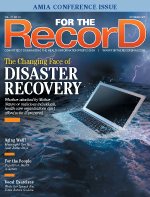October  2015
2015
The Secrets to Patient Engagement
By Diana Keough
For The Record
Vol. 27 No. 10 P. 28
America's health care processes are shifting. While today's medical professionals are faced with an abundance of health care initiatives, they also are being incentivized to place a stronger emphasis on patient engagement as the industry strives for population health. To succeed, patients must become more responsible for their own health and managing their conditions. On the other end of the equation, it's up to health care professionals to provide patients with the correct tools and resources to accomplish these goals.
The industry has utilized various channels and content formats to directly reach and engage patients. Nevertheless, consumers are continuing to self-educate online. With the success of sites such as WebMD and Facebook, it's clear that consumers trust digital media as a resource for health and wellness information. In fact, MediaBistro found that 40% of consumers say that information found on social media sites affects how they manage their health. This shift toward self-education illustrates that engaging online content, including custom health and wellness videos, articles, and visuals, is vital to both managing existing patients and attracting new patients to a health care practice.
An Impactful Voice
One format proven to increase engagement is "storytelling," which captures a real-life patient's experiences in order to inform consumers about various health and wellness topics. Why is this format so effective? To quote author Janet Litherland, "Stories have power. They delight, enchant, touch, teach, recall, inspire, motivate, challenge. They help us understand. They imprint a picture on our minds. Want to make a point or raise an issue? Tell a story."
Through patient storytelling, health education is communicated and captured in a new and profound way. By gathering information from the patient's voice as opposed to that of a medical professional, the information becomes relatable, sometimes even emotional.
Through video, nonverbal emotional cues and experiences effectively capture the challenges patients face in their everyday lives. With online health self-education on the rise, high-impact patient storytelling presents the perfect opportunity for physicians to transfer their knowledge and best practices through the voice of someone else, ensuring that critical health education resonates with patients.
Motivation to Become Proactive
A resulting benefit of increased engagement is that patients and consumers become more motivated to take a proactive approach to their own health management as well as their loved ones' health issues. By seeing and listening to challenges patients face, consumers are far more likely to take action to prevent similar outcomes.
For example, patients who watch a video about the importance of wearing sunscreen told from the point of view of someone suffering from melanoma are much more likely to apply suntan lotion or schedule a checkup no matter how many times they've heard a physician recommend it. Access to online content and compelling videos encourages patients to educate themselves and become more proactive in their health, whether or not they fully realize it.
In addition to providing motivation, patient storytelling raises awareness about a much broader spectrum of topics related to health issues and concerns, such as side effects and mental and emotional challenges.
Uncomfortable Health Care Issues
By covering a wide range of health issues, patient stories shared online also help dissolve stigmas associated with the many conditions that affect our health beyond traditional illnesses. Whether it's grief from the death of a loved one, alcoholism, or mental health disorders, patients are traditionally less likely to speak out and seek advice or help because of the negative connotations associated with these conditions. However, when patients identify commonalities and relate to someone going through these same issues, they often become less embarrassed to discuss them with their physicians; this could ultimately have a profound effect on their lives.
Effective stories require finding patients who are willing to talk about a wide spectrum of health issues and communicate their experiences effectively in order to encourage others to adopt preventive measures. Although it can be cumbersome for health care facilities to organize and produce these stories on their own, there are opportunities to obtain and leverage this type of professional content through licensing.
A Portal of Patient Stories
Implementing licensed online content portals eradicates resource and logistical challenges for providers. Instead of having to obtain and produce a multitude of stories, providers can customize content to present the most useful topics to their patients. Online portals can be easily accessed through a single sign-on, making them a go-to resource for patients at any time, from any device. And because licensed health and wellness content portals must comply with HIPAA regulations, there are no issues with the content type being added to patient medical records. In fact, the portals serve as a one-way stream of accessible information that patients can freely and anonymously access to engage and self-educate.
In return, the combination of convenience and highly visual material creates an overall higher patient engagement rate. In fact, when Healthgrades.com, a portal that connects patients with doctors, replaced a written article on bipolar disorder with a visual slideshow that included video and patient images, page views on this section of the site increased from 1.5 to six per session.
Ultimately, by increasing awareness about understated health issues and motivating patients to engage in preventive care methods for themselves and loved ones, licensed online content portals help improve overall population health. These benefits can decrease unnecessary doctor visits and emergency department admissions that waste physicians' time and providers' money.
The more access consumers have to compelling content through credible online health care resources, the more aware and proactive they become. By raising public health awareness and decreasing unnecessary hospital visits, health care professionals will ultimately be able to allocate resources where they are needed most: to patients in need.
— Diana Keough is CEO, founder, and editor-in-chief of ShareWIK.



